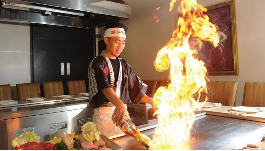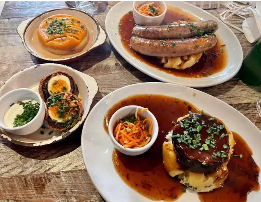In addition to these three types of Japanese cuisine, there is another type of Japanese cuisine that you will never know!
5 min read
Japanese cuisine is divided into three main categories, namely, honshan cuisine, Kaiseki cuisine and Kai Mat cuisine.This food Originating from the Muromachi era, this cuisine is a traditional cooking system based on culture and habits, as well as a product of the Japanese Rifa system.It is characterized by a strong sense of ritual, which is a very formal and varied Japanese cuisine. Dish plate or bowl will put “discount apply (お し き)” show up, on the discount apply is a kind of small square table. The first fold apply call this board, then down three の is の meals, meal. The cooking is based on three dishes in one juice (soup), and the number of dishes will be increased according to the size of the reception and scene, such as two five dishes, three seven dishes, three fifteen dishes, but the number of dishes must be odd.
Formal “home-cooked food” is not common anymore. It only appears on a few formal occasions, such as weddings and funerals, coming-of-age ceremonies and sacrificial feasts. The dishes range from five dishes and two soups to seven dishes and three soups.
In addition to the diet, there is also Xian, which means for everyone to drink wine, and each offering also has its corresponding cooking. The most basic ritual is the “three offerings”, which means drinking three rounds of wine in a certain order before eating the meal. After three rounds of wine, dinner began. But the cuisine has been on the decline since the Meiji era, and in modern times, it is mostly seen at a few very formal occasions. However, there is no change in the system of our cuisine, which will basically follow the previous etiquette.
Kaiseki In Japanese cuisine, the earliest and most orthodox cooking system is Kaiseki, which has a history of more than 450 years.
In medieval Japan (referring to the Kamakura and Muromachi eras of Japan), the tea ceremony was formed, and the elaborate dishes prepared for guests before the tea ceremony, thus Kaiseki was formed at this time.
Kaiseki cuisine originated from the tea ceremony. It is said that Kaiseki, a tea man, made it to protect his stomach and avoid drinking tea on an empty stomach during tea parties. There are two theories circulating about the explanation for Kaiseki.
Statement 1: It is related to the practice of Zen Buddhism. It means that in the practice of meditation, in order to endure the hunger in the abdomen, warm baked stones are placed in the arms, which can not only resist hunger but also keep out the cold. So Kaiseki cuisine, which is eaten before the tea ceremony, is usually served with “three dishes in one sauce” on a tray. The main function is to protect the stomach and intestines.
Theory 2: In Chapter 70 of Tao Te Ching, written by Laozi from China, there is a sentence: “It is the sage who is beguined with jade.” Be brown, thin outside; Those who cherish jade, thick inside. The surface is rough, but the heart is beautiful jade. Ignore the value of the external and inherent, this kind of idea and the Japanese tea ceremony “wabi び ji び” spirit perfectly.
Although the origins of Kaiseki banquet cuisine are different, the pronunciation of Kaiseki banquet cuisine is the same in Japanese. The traditional kaiseki consists of three dishes: rice, miso soup, toku (sashimi), bowl (boiled), and roast and soup. With the change of generations, the dishes of kaiseki nowadays have become more diversified. Besides the basic three dishes in a soup, there are also more dishes such as prepot, sponge and hachin (starter), which has become the synonymous of luxury cuisine.
The main difference in Kaiseki cuisine is the form of the meal. Kaiseki cuisine advocates a slow, sequential tasting of food, with dishes presented one by one, interwoven with wine, soup and side dishes; Banquet cooking, on the other hand, presents colorful combinations of ingredients in front of guests in a light and relaxed environment. In addition, the order of serving food is the opposite of Kaiseki cuisine, since banquets centered on wine.
Know how to cook With the foundation of Kansei cuisine and Kaiseki, and the development of social activities among ordinary people in Japan, Hoi Mat cuisine evolved.
Yakuza is usually available in restaurants that specialize in Japanese food.
It was originally referred to as a gathering of haiku. Since the Wenzheng period of the Edo period, many of the gathering was held in tea houses. As a result, the food for the gathering became more and more elaborate. Unlike this cuisine, banquet cuisine does not pay attention to etiquette and form. The dining style of banquet is relatively free. Enjoying the delicious food in a relaxed way is its biggest feature. The dishes of the meeting meal are pre-paid (starter), bowl (sponge), and pre-paid (sashimi), poyao (grilled), strong yao (boiled), and non-fried yao (vinegar or cold), accompanied by rice, miso soup, and miso sauce. Some of them are fried, steamed or cooked to make the dishes more luxurious and rich.
With the change of times, Hoi Mat cuisine has also begun to absorb cuisines from all over the world, and its dishes have become more and more diversified. It can be said that Hoi mat cuisine is a traditional Japanese cuisine that “keeps pace with The Times”.
pack cookingIn the development of Japanese cuisine, there is another form of cuisine that is closely associated with the culture of our country: blabb cuisine.Originated from the ancient vegetarian cuisine of China, blaring refers to Chinese style dinner table, which generally refers to the eight exquisite table of different varieties of mushroom, fish cake, noodle soup with vegetables and brised noodles etc. The characteristic of blaring is that the guests sit round a table with backrest chairs and all the meal is put on the same table.






